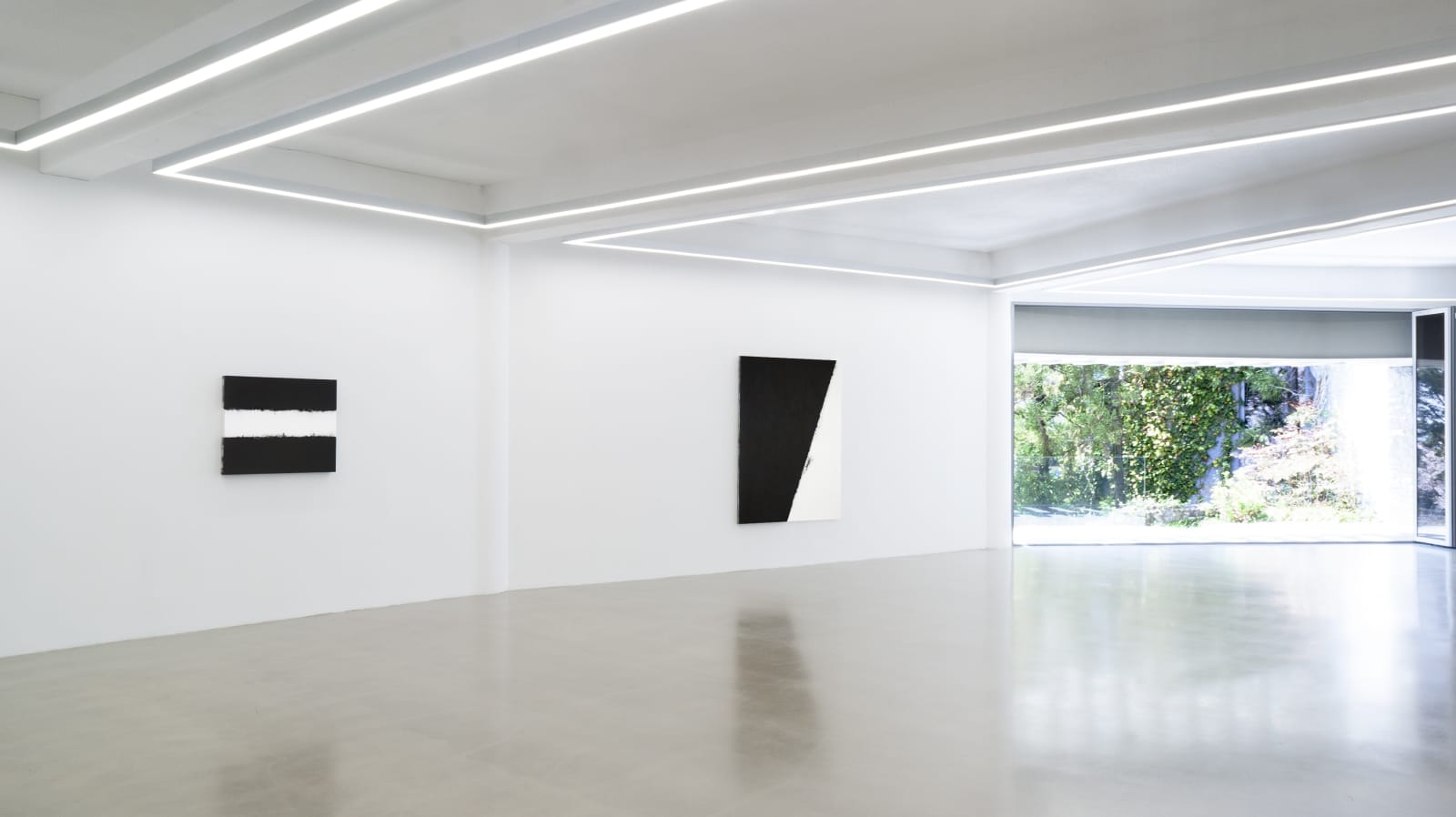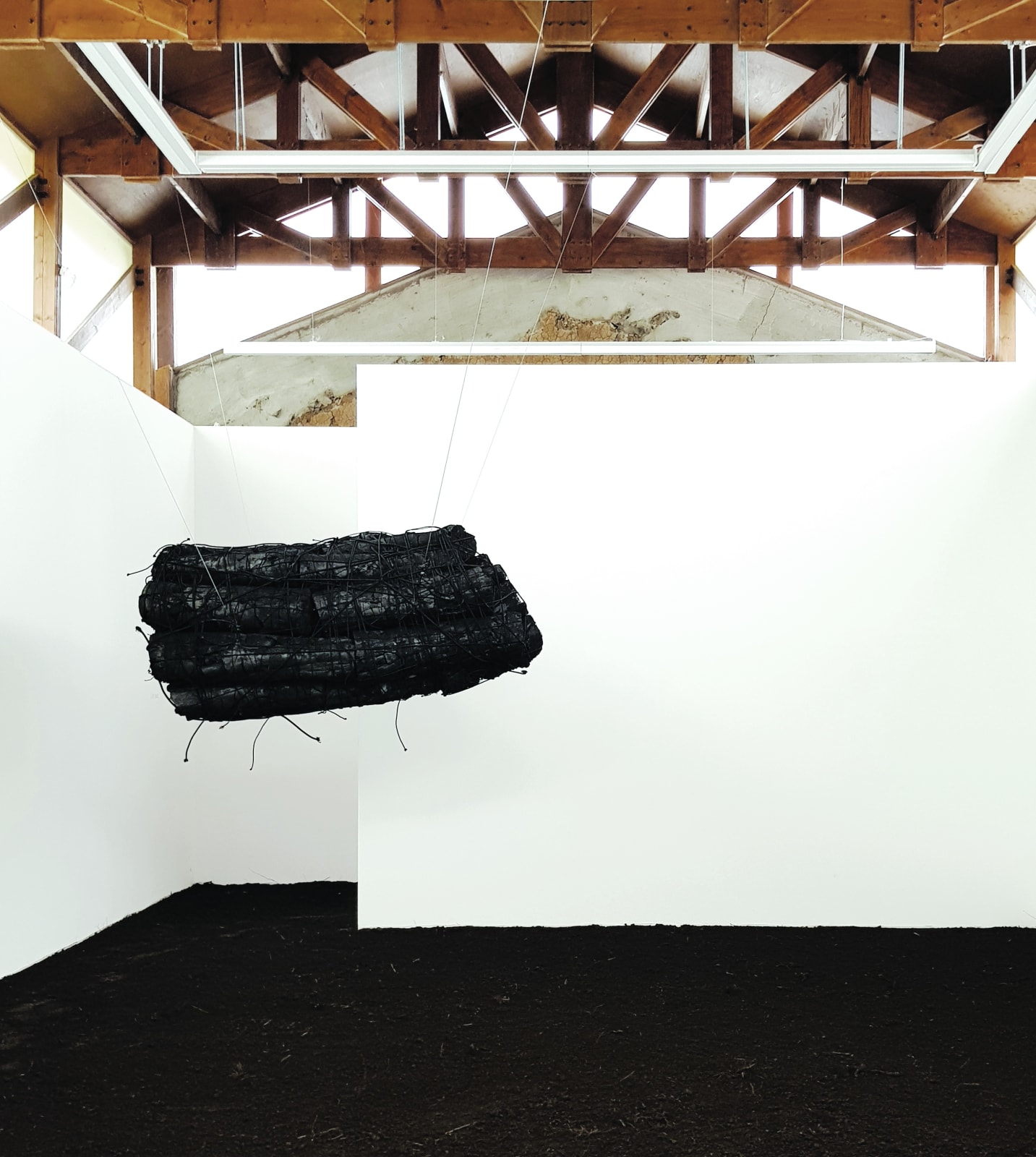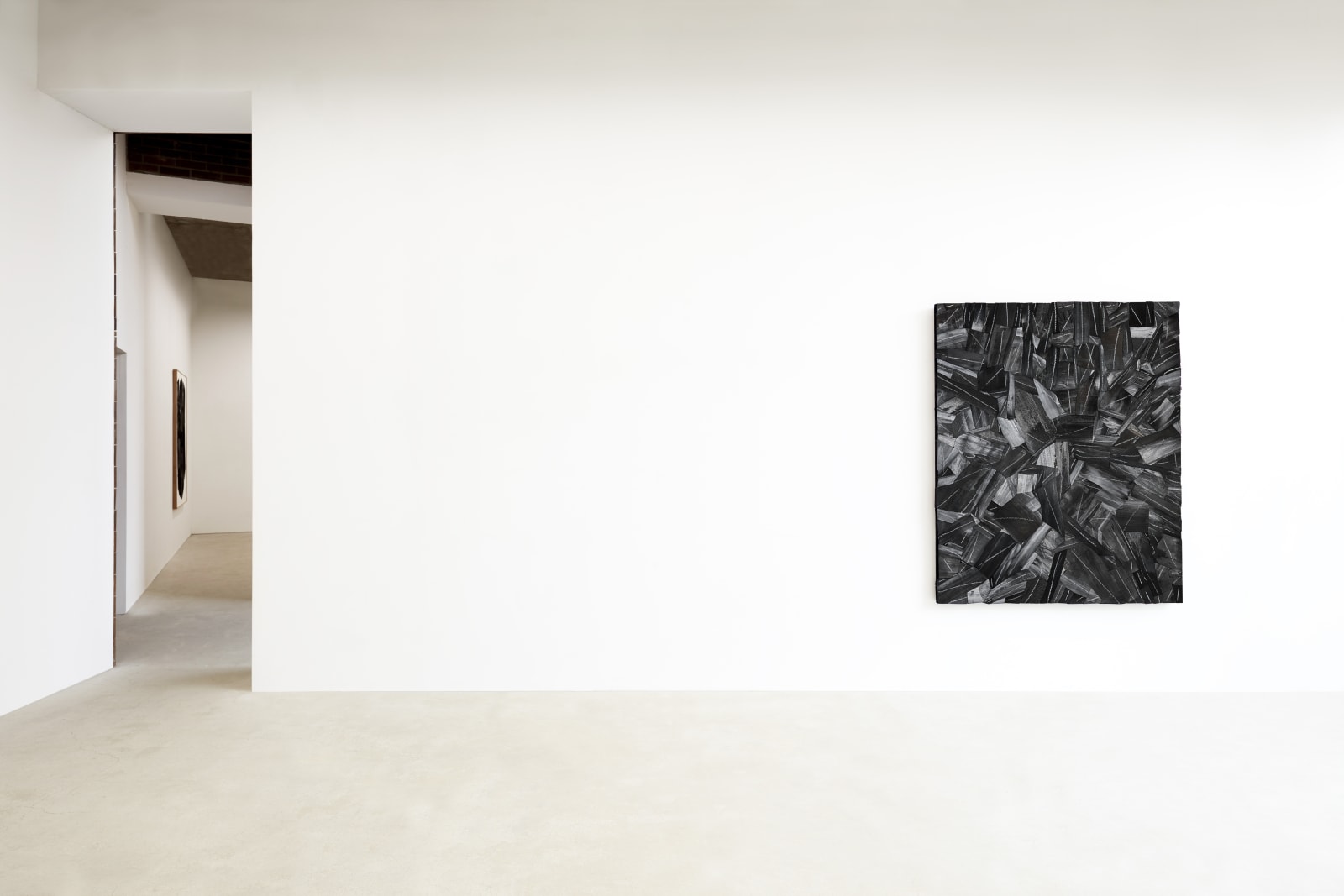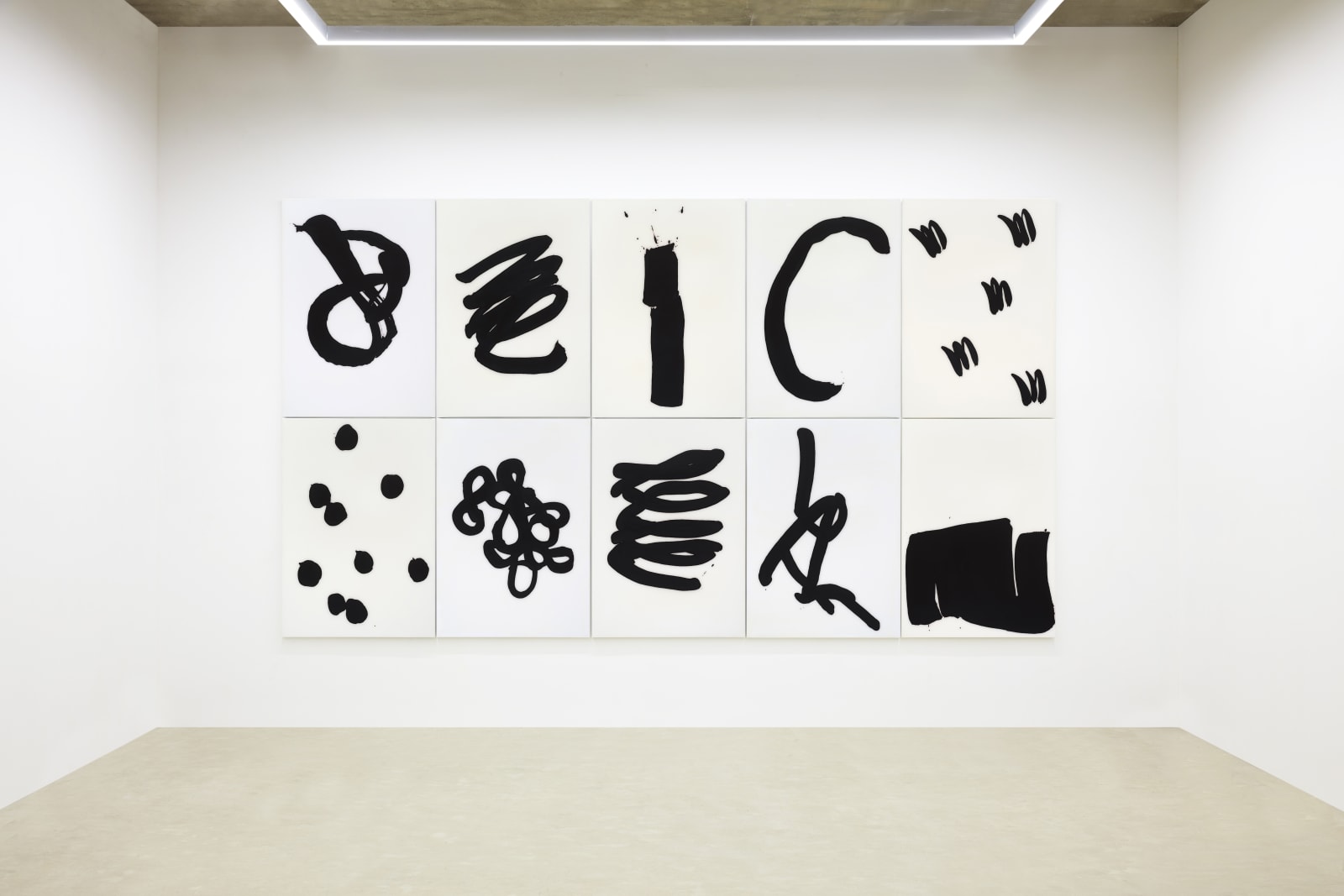이배: 이배 Lee Bae
부산 조현화랑 달맞이와 해운대, 서울 갤러리2, 그리고 제주도 갤러리2 중선농원에서 이배 작가의 개인전이 동시에 열린다. 조현화랑 달맞이와 갤러리2에서는 <Issu du feu>를 비롯해 <Landscape>, <Acrylic medium>, <Drawing>등 작가의 대표 작품이 전시되며 조현화랑 해운대, 갤러리2 중선농원에서는 대형 설치 작품인 <Landscape>와 <Issu du feu - suspens>를 선보일 예정이다. 신작 <Drawing> 시리즈를 비롯하여 30여점이 공개되는 이번 개인전은 숯을 통해 삶과 예술에 대한 작가의 태도를 보여주는 전시가 될 것이다.
숯의 작가 이배. 이렇게 쉽고 명확하게 작가를 설명할 방법이 또 있을까. 그만큼 숯이 지닌 물리적 속성과 철학적 관념이 그의 작품을 설명하는 데 늘 빠지지 않는다. 때때로 혹은 언제나 우리는 그에게 왜 숯을 사용하는지 묻는다. 이유는 무수히 많다. 프랑스 체류 시절에 숯을 사게 된 사연, 숯과 한국의 전통문화, 숯의 제작 과정에 담긴 생명의 소멸과 탄생, 숯에서 만들어진 먹과 동양 문화, 검은색에 담긴 의미 등 수없이 살을 붙여 나갈 수 있다. 하지만 이것은 작품이 아닌 숯에 대한 해석일 뿐이다. 중요한 것은 숯이 더 이상 ‘숯이 아닌 것’을 가리키고 있다는 것이다.
여기서 그의 작업을 복기할 필요가 있다. <Issu du feu>는 1991년부터 시작된 작품이다. 숯을 잘라 캔버스에 부착하고 그 위에 전체적으로 아라비아 고무를 덧칠한다. 부드러운 사포로 표면을 갈면 숯가루와 고무가 섞여 나무의 빈틈을 메운다. 이배 작가는 숯의 거친 표면과 반사되는 검은 빛을 그대로 드러낸다. 자신이 사용하는 대상의 물질성을 드러내는 것이다. <Landscape>에서 검은 숯과 하얀 여백이 만나는 경계는 대지를 연상시킨다. 그의 작품은 두껍게 쌓인 토양층, 바람에 흩어지는 토양 입자 그리고 비가시적인 대기와 다름이 없다.
<Acrylic Medium>은 목탄에서 추출한 검은 안료로 캔버스 위에 형태를 그리고 밀랍 같은 두꺼운 재료를 여러 번 덮은 작업이다. 작가는 마치 동양화에서 종이에 먹이 스며들듯이 그의 제스쳐를 화면 안으로 정착시키고 싶었다고 한다. 최근작인 <Drawing>은 큰 붓으로 화면에 제스쳐의 흔적을 기록한다. 작가는 겸재 정선이나 김환기의 작품에서 느껴지는 특유의 감수성, 가변성, 빛과 흔들림, 습윤성이 과연 어디에서 왔는지 늘 궁금했다고 한다. 그리고 그는 이것이 비가 많이 오고 습한 몬순 기후 지역의 문화라고 추측한다. 물을 먹은 안료가 마른 종이를 지나가면서 물길을 만든다. 그는 자신의 태어난 자연의 성질을 묘사하고 있는 것이다.
설치 작품인 <Landscape>는 대지를 묘사했던 평면 작업의 연장선이다. 입체 작업은 대지를 묘사하는 것을 넘어 자연의 다듬어 지지 않은 비정형성과 육중함을 우리에게 현전시킨다. <Issu du feu - suspens>는 바닥에 쌓인 흙더미와 공중에 부유하는 숯덩어리로 구성되어 있다. 작가는 공중에 떠 있는 숯을 통해 물성으로부터 벗어난 하나의 영적인 존재를 표현하고 싶었다고 한다. 이는 하늘과 땅 사이에 그 둘을 이어주는 메신저일 수도 있다.
거봐. 숯이 모든 것을 해냈잖아. 누군가는 이렇게 말할 수도 있다. 작가가 숯의 특성을 중요시하는 것은 맞다. 그는 숯을 사용하는 이유가 그 안에 인간이 통제할 수 없는 거대한 자연이 존재하기 때문이라고 말한다. 그런데 이 말에는 전제가 있었다. 그의 말은 다시 인용되어야 한다. “숯을 좋아한다기보다 숯은 그저 ‘하찮은 물건’이지만 그 안에 거대한 자연, 인간이 통제할 수 없는 힘을 발견할 수 있다.” 과연 숯에 자연의 힘이 존재할까. 아니다. 그것은 숯이 아니라 작가의 마음속에서 발현된 것이다. 특별한 존재라 하더라도 그것을 알아보지 못하는 사람의 눈에는 그저 하찮은 것으로 보일 뿐이다. 그리고 존재의 특별함을 찾아내는 것이 예술가의 일이다.
대상은 생각하고 말하는 주체와의 관계에서만 의미가 있다. 숯의 존재가 강렬하게 느껴지는 것은 작가와 그가 사용하는 재료 사이에서, 그리고 작가가 제안하는 예술적 해석에서 뿜어져 나오는 것이다. 예술의 신비는 바로 거기에 있다. 그림을 볼 때 형태, 색감, 그리고 화가의 메시지를 찾으려고 하지 물감과 캔버스의 역사나 문화적 가치를 먼저 말하는 사람은 없다. 그런데 우리는 지금까지 그런 오류를 범하고 있었는지 모른다. 숯의 의미에 집중하다 보니 작품 그 자체가 전달하려는 메시지와 조형성을 의식하지 못하는 그런 위험 말이다. 마지막 질문. 여전히 숯의 의미를 추적하는 데 만족하는가. ‘숯의 작가’라는 수식어는 더 이상 위안이 되지 않는다.
Artist Lee Bae presents his latest exhibition simultaneously across multiple venues across Korea: Johyun Gallery Dalmaji and Johyun Gallery Haundae, GALLERY2 in Seoul, and GALLERY2 Joongsun Nongwon in Jeju-do. Johyun Gallery Dalmaji and GALLERY2 Seoul feature Lee's seminal works including 〈Issu du feu〉, a canvas interpretation of 〈Landscape〉, 〈Acrylic Medium〉, and 〈Drawing〉. Johyun Gallery Haeundae and GALLERY2 Joongsun Nongwon feature a spatial iteration of 〈Landscape〉 and 〈Issu du feu - suspens〉, both large-scale installation works by the artist. Lee's multi-venue exhibition features approximately 30works, including the artist's latest 〈Drawing〉, inviting visitors to take a closer look at the artist’s life and relationship with charcoal.
'Charcoal artist' is an obvious description of Lee Bae. His oeuvre is bound to explanations of charcoal in terms of its physical and metaphysical connections. As a result, a recurring - or persistent - question is 'why use charcoal?' To which, Lee has provided many reasons, dozens of times, ranging from when he was in France and how he came to purchase charcoal, the relevance of charcoal and traditional Korean culture, the concept of creation and extinction of life embodied in how charcoal is produced, the significance of blackness, to state just a few. Yet these are interpretations of the material - not the art itself. The given reasons seem to discuss charcoal, but without exception end at something that is not charcoal.
A deeper appreciation of Lee’s works is in order, with a retrospection reaching back to 〈Issu du feu〉 which began in 1991. The canvas work was made by a process where the artist attached cut pieces of charcoal to the canvas and applied a layer Arabian gum rubber to the surface. The surface was then gently sanded down, the residue of soot and gum settling into the gaps between tiled charcoal. The noir sheen was brought forth, despite the uneven charcoal surface; a tonal evocation of the artist's chosen material. Then in 〈Landscape〉, Lee contrasted black charcoal against white space, reminiscent of geological strata of the great earth. The presentation was drawing parallels to the Earth’s thick sedimental layers, the wind-blown particles on the surface, and the invisible atmosphere.
〈Acrylic Medium〉 is created from a mixture of charcoal pigments and acrylic paint. The artist’s gesture is on canvas is laminated numerous times using clear acrylic with wax-like viscous consistency. Lee describes the process as feeding his motives into the layered depth of the canvas, emulating what happens in oriental paintings with India ink on mulberry paper. 〈Drawing〉, his most recent work is a brush-traced record of his gestures over the canvas. Lee points to Jeong Seon (1676-1759, quintessential Korean landscape painter, also known by his pen name Kyomjae) and Kim Whanki (1913-1974, pioneered abstract art and was a critical proponent of modern art in Korea) as inspiration for his latest work. Lee looks to their works with great fascination, pondering the source of their unique tonality, versatility, luminous treble, and wettability. Lee speculates that much of the characteristics associated with Jeong Seon and Kim Whanki were idiosyncratic to the rainy and humid atmosphere of monsoon-prone regions. When liquid, pigmented ink glides over dry paper, the moisture draws a path. Lee is in a way, expressing the idiosyncrasies of the place where he was born.
The space installation work of 〈Landscape〉 is three-dimensional expansion of the work sharing the name, depicting the great earth. 〈Issu du feu - suspens〉 consists of a pile of dirt on the floor and a large mass of charcoal floating above. Lee describes it as a spiritual presence transcending the burden of materiality, a state which heralds heaven and earth.
Some might say that charcoal is truly the end-all of Lee Bae, as the artist's grasp and utility of charcoal is clearly evident. "It is the presence of nature in its intractable immensity embodied by charcoal" that compels Lee to use it. Lee's given reason needs to be paraphrased, as it is based on a premise. "It is not my personal preference for charcoal per se; it can be quite insignificant, yet it the force of nature and the immense power within it, intractable by humanity, that I recognize in charcoal.” What of charcoal embodies the power of nature? Or does it? Perhaps it is in the eye of the mind, not the charcoal. After all, it is the observant gaze which recognizes and gives meaning. Those who will not see simply won’t, and it is the artist who recognizes how odd it is to be anything at all.
Things become meaningful through interaction with the observer capable of thought and utterance. That is to say, the compelling presence of charcoal emanates from the artist's choice of material and artistic interpretation. If there is any mystery in art, that is where it is. How obtuse it is to gaze upon art to ignore its form, color, and ideas only to comment upon what paint and canvas was used, and where their cultural significances lie. Somehow we gaze upon Lee's works with such a blind eye; too soon to attach our attention upon charcoal, overlooking form, color, and what it wishes to convey. So ask if there is greater satisfaction to be found unpacking the blackness of charcoal. Heaven forbid that answer find 'charcoal artist' appropriate.












